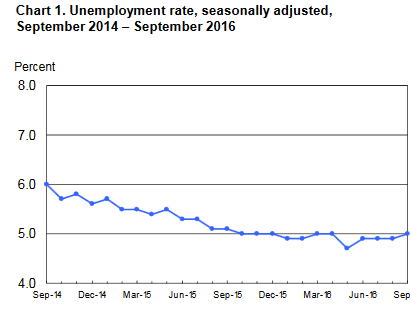Employment Blog October 2016
This report is from the U S Department of Labor, Bureau of Labor Statistics. Nonfarm payroll employment increased by 156,000 in September, and the unemployment rate was little changed at 5.0 percent. Job gains occurred in professional and business services and in health care. Thus far this year, nonfarm job growth has averaged 178,000 per month, compared with an average gain of 229,000 per month in 2015. Incorporating revisions for July and August, which reduced nonfarm payroll employment by 7,000 on net, monthly job gains have averaged 192,000 over the past 3 months.
This information is summarized the Charts 1 and 2 below.
Professional and business services employment rose by 67,000 in September and by 582,000 over the year. Within the industry, employment in management and technical consulting services increased by 16,000 over the month, and employment continued to trend up in administrative and support services (+35,000).
Health care added 33,000 jobs in September, with gains in ambulatory health care services (+24,000) and hospitals (+7,000). Over the past 12 months, health care employment has grown by 445,000.
Employment continued to trend up in food services and drinking places (+30,000) in September. Over the year, this industry has added 300,000 jobs.
Employment also continued to trend up over the month in retail trade (+22,000) and was up by 317,000 over the year.
Mining employment was flat in September; the rate of job loss in the industry had been moderating in recent months.
Employment in other major industries, including construction, manufacturing, wholesale trade, transportation and warehousing, information, financial activities, and government, changed little over the month.
Below are forecast or trends in areas of employment for the 2014 to 2024 time period.
The civilian labor force is projected to reach 163.8 million in 2024, growing at an annual rate of 0.5 percent.
The labor force continues to age. The median age of the labor force was 37.7 in 1994, 40.3 in 2004, 41.9 in 2014, and is projected to be 42.4 in 2024. At the same time, the overall labor force participation rate is projected to decrease from 62.9 percent in 2014 to 60.9 percent in 2024.
The labor force participation rate for youth (ages 16 to 24) is projected to decrease from 55.0 percent in 2014 to 49.7 percent in 2024. The youth age group is projected to make up 11.3 percent of the civilian labor force in 2024 as compared with 13.7 percent in 2014. In contrast, the labor force participation rate for the 65-and-older age group is projected to increase from 18.6 percent in 2014 to 21.7 percent in 2024. This older age group is projected to represent 8.2 percent of the civilian labor force in 2024 as compared with 5.4 percent in 2014.
Labor force diversity is projected to increase, with white non-Hispanics making up 59.6 percent of the civilian labor force in 2024, compared with 64.6 percent in 2014.
Real GDP (2009 chained dollars) is projected to grow at an annual rate of 2.2 percent, from $16.1 trillion in 2014 to $19.9 trillion in 2024.
Within GDP, medical services will continue to grow as a share of nominal personal consumption expenditures. This category is projected to account for 18.0 percent of consumption in 2024–higher than its 16.7-percent share in 2014 and 15.0-percent share in 2004.
Service-providing sectors are projected to capture 94.6 percent of all the jobs added between 2014 and 2024. Of these 9.3 million new service sector jobs, 3.8 million will be added to the healthcare and social assistance major sector. The healthcare and social assistance major sector is expected to become the largest employing major sector during the projections decade, overtaking the state and local government major sector and the professional and business services major sector. Healthcare and social assistance is projected to increase its employment share from 12.0 percent in 2014 to 13.6 percent in 2024.
Construction is projected to add 790,400 jobs by 2024. Even with these additional jobs, employment in the construction major sector is not projected to return to the 2006 peak.
Manufacturing employment, between 2014 and 2024, is projected to decline at a 0.7 percent rate annually, a more moderate decline than the 1.6 percent rate experienced in the prior decade.

